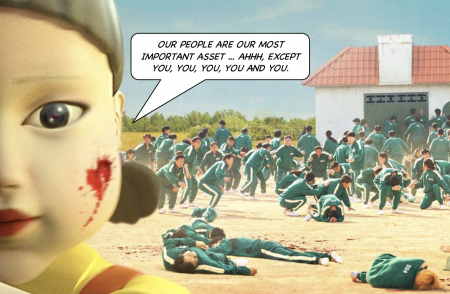Reduction in force
|
|
Reduction in force
rɪˈdʌkʃən ɪn fɔːs (n.)
The permanent removal of headcount — mass redundancy — usually targeted at that sweet spot in the organisation whose own reports aren’t so useless they can’t get by without supervision by someone who genuinely knows what is going on, and who aren’t so senior that they get to make decisions about who should be subject to a RIF. Usually, therefore, largely mid-ranking subject matter experts.
A word about line management: a modern corporation is organised like an inverted, multilayer family tree, trading back to great, great, great, great grandfather Hank. Everyone, bar Hank, has at least one line manager. Fortunate staff have only one: les miserables have a “dotted line” into someone else. Having a dotted line is somewhat like having an open relationship or an affair with a distant uncle. But we digress.
The basic job of line management is to supervise direct reports. Line managers all have other things to do besides supervising their direct reports, though the mix of Three things change the higher up the multi level marketing scheme you go:
- executives get paid more. It is no linear progression, but something more like an exponential curve. There are many, many Belarusians on 30 grand, only ten executive board members on five million a piece.
- the proportion of your time spent on line management increases — we take this to be a trivial observation: the contractor at the call centre in Belarus has no direct reports, so soends no time managing; the CEO ultimately has every direct report, so does almost nothing but line managing.
- the purpose of your upward line management shifts: the Belarusian contractor who arrived from the job-centre in Minsk in knows nothing: his interaction with his manager is almost completely substantive, functional and necessary: the chief operating officer has been at the firm forty years, knows its every idiosyncracy and foible; her interaction with her live manager is almost entirely formal: when she presents issues to her boss she should know the answers as well as her boss will
